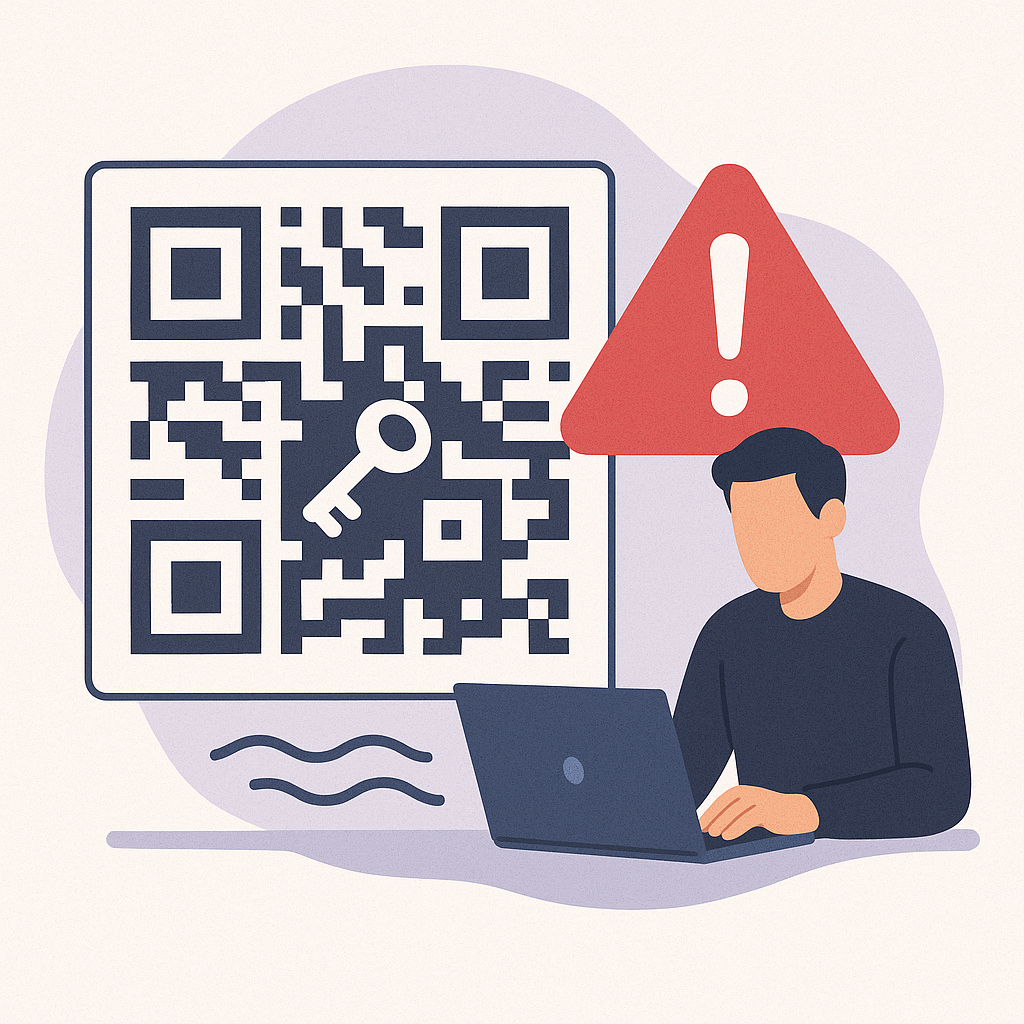The Hidden Dangers of QR Code Private Key Generators
Why Online QR Code Tools Threaten Your Cryptocurrency Security
In the rapidly evolving cryptocurrency landscape, QR codes have become ubiquitous tools for simplifying blockchain transactions and wallet management. However, beneath their convenient facade lies a critical security vulnerability that threatens millions of digital asset holders worldwide. The practice of using online QR code generators for private key management represents one of the most overlooked yet dangerous security risks in the crypto ecosystem.
Understanding the QR Code Security Landscape
QR codes serve as digital bridges between complex cryptographic data and user-friendly interfaces. When dealing with cryptocurrency private keys, these square-shaped matrices encode sensitive information that grants complete access to digital wallets. The convenience factor has led many users to turn to readily available online generators, unknowingly exposing themselves to sophisticated attack vectors.
⚠️ Critical Security Alert
Every private key processed through an online QR generator creates a permanent digital footprint that can be exploited by malicious actors. This exposure occurs regardless of whether the website claims to process data locally or promises not to store information.
The Anatomy of QR Code Vulnerabilities
Modern QR code generators operate through various mechanisms, each presenting unique security challenges. Understanding these vulnerabilities requires examining the data flow from input to output, identifying potential interception points where sensitive information becomes compromised.
- Server-Side Processing: Most online generators process QR code creation on remote servers, meaning your private key data travels across the internet and gets temporarily stored on third-party infrastructure.
- Browser Cache Exploitation: Web browsers automatically cache various types of data, potentially storing QR code images containing private keys in temporary files accessible to other applications.
- Network Traffic Interception: Unencrypted or poorly encrypted connections allow network monitoring tools to capture private key data during transmission to QR generation services.
- Third-Party Analytics: Many websites integrate analytics tools that may inadvertently log sensitive data, creating additional exposure points for private key information.
Real-World Attack Scenarios and Case Studies
The theoretical risks associated with online QR generators have materialized into documented security breaches affecting cryptocurrency users globally. Analyzing these incidents reveals patterns that highlight the sophistication of modern crypto-targeted attacks.
The Clipboard Hijacking Connection
Recent security research published by KrebsOnSecurity has documented numerous cases where QR code generators served as initial attack vectors for more complex cryptocurrency theft schemes. Attackers often combine QR code data harvesting with clipboard monitoring malware, creating multi-layered attack strategies.
Database Breach Implications
When QR code generation services experience data breaches, the consequences extend far beyond typical website compromises. Private keys stored in compromised databases provide attackers with immediate access to cryptocurrency wallets, often resulting in irreversible asset theft.
- Historical Data Exposure: Breached databases may contain QR code generation history spanning months or years, exposing private keys that users believed were processed securely.
- Cross-Platform Correlation: Attackers combine QR code data with information from other breached services to identify high-value targets and optimize their attack strategies.
- Automated Wallet Scanning: Sophisticated attack operations use automated tools to systematically check compromised private keys against multiple blockchain networks, maximizing their potential returns.
- Delayed Attack Execution: Smart attackers often wait extended periods before accessing compromised wallets, allowing victims to accumulate more valuable assets before executing theft operations.
Technical Analysis of QR Code Generation Vulnerabilities
The technical infrastructure underlying online QR code generators creates multiple vulnerability surfaces that extend beyond obvious security concerns. A comprehensive analysis reveals how seemingly innocuous features can compromise private key security.
| Vulnerability Type | Risk Level | Attack Vector | Mitigation Difficulty |
|---|---|---|---|
| Server-Side Logging | Critical | Database Mining | Impossible for Users |
| Network Interception | High | Traffic Analysis | VPN Required |
| Browser Cache Storage | High | Local File Access | Manual Cache Clearing |
| Third-Party Scripts | High | Code Injection | Script Blocking Required |
| DNS Poisoning | Medium | Traffic Redirection | Secure DNS Required |
JavaScript-Based Processing Myths
Many online QR generators claim to process data entirely within the user's browser using JavaScript, supposedly eliminating server-side risks. However, security experts from Schneier on Security have demonstrated that client-side processing claims often mask hidden data transmission mechanisms.
🔍 Technical Reality Check
Even JavaScript-based QR generators typically load external libraries, fonts, or analytics scripts that can capture and transmit sensitive data. The complexity of modern web applications makes it virtually impossible for users to verify true client-side processing claims.
The HTTPS Encryption Fallacy
While HTTPS encryption protects data during transmission, it provides no safeguards against server-side data logging or storage. Many users mistakenly believe that HTTPS-enabled QR generators offer complete security, overlooking the fundamental trust issues inherent in third-party processing.
Industry Best Practices and Professional Recommendations
Cryptocurrency security professionals and blockchain developers have established comprehensive guidelines for secure private key management that explicitly discourage online QR code generation. These industry standards reflect years of security research and real-world incident analysis.
Professional Development Standards
Leading cryptocurrency wallet developers implement strict security protocols that prevent private key exposure during QR code generation. According to security guidelines published by OWASP, secure QR code generation must occur within isolated, offline environments that never transmit sensitive data to external services.
- Air-Gapped Generation: Professional security practices mandate QR code creation on completely offline systems with no network connectivity, eliminating remote attack vectors.
- Memory Management: Secure applications immediately clear private key data from system memory after QR code generation, preventing residual data exposure.
- Cryptographic Verification: Professional tools implement checksums and cryptographic verification to ensure QR code accuracy without requiring external validation services.
- Hardware Isolation: Enterprise-grade security solutions utilize dedicated hardware modules for QR code generation, physically separating sensitive operations from general-purpose computing environments.
Regulatory Compliance Considerations
Financial institutions dealing with cryptocurrency custody must adhere to strict regulatory requirements that prohibit third-party processing of private key material. These regulations provide valuable frameworks for individual users seeking to implement professional-grade security practices.
⚖️ Regulatory Insight
Major financial regulatory bodies classify private key exposure through third-party services as a compliance violation equivalent to sharing banking credentials with unauthorized entities. This classification reflects the serious nature of private key security in institutional contexts.
Secure Alternatives and Implementation Strategies
Implementing secure QR code generation for private keys requires adopting tools and practices that prioritize data isolation and user control. The following approaches provide practical alternatives to risky online generators while maintaining usability and functionality.
Offline Software Solutions
Dedicated offline QR code generation software eliminates network-based attack vectors while providing professional-grade functionality. These applications operate independently of internet connections, ensuring complete data isolation during the generation process.
- Standalone Applications: Desktop software designed specifically for cryptocurrency QR code generation offers maximum security through complete network isolation and local processing.
- Open Source Verification: Publicly auditable source code allows security experts to verify the absence of hidden data transmission or logging mechanisms.
- Hardware Wallet Integration: Many secure QR generators integrate directly with hardware wallets, ensuring private keys never exist in unencrypted form on general-purpose computing devices.
- Multi-Platform Compatibility: Professional offline generators support multiple operating systems while maintaining consistent security standards across different computing environments.
Hardware-Based Generation Methods
Specialized hardware devices designed for cryptocurrency key management often include built-in QR code generation capabilities that operate independently of connected computers or mobile devices.
🔐 Hardware Security Advantage
Hardware-based QR generation ensures that private keys never leave the secure element of the device, providing cryptographic isolation that software-based solutions cannot match. This approach represents the gold standard for professional cryptocurrency security.
DIY Security Implementation
Advanced users can implement custom QR code generation solutions using open-source libraries and secure development practices. This approach requires technical expertise but provides maximum control over the security implementation.
- Library Selection: Choose well-audited open-source QR code libraries with established security track records and active maintenance communities.
- Environment Isolation: Implement generation processes within virtual machines or containers that can be completely destroyed after use, eliminating data persistence risks.
- Code Auditing: Thoroughly review all dependencies and third-party components to ensure they don't introduce hidden vulnerabilities or data transmission mechanisms.
- Testing Protocols: Implement comprehensive testing procedures that verify QR code accuracy while maintaining security isolation throughout the generation process.
Future Implications and Emerging Threats
The evolution of cryptocurrency attack methodologies continues to outpace user awareness and security practices. Understanding emerging threat patterns helps users prepare for future security challenges while implementing robust defensive strategies.
Artificial Intelligence Attack Enhancement
Modern attackers increasingly leverage artificial intelligence to optimize their targeting strategies and improve attack success rates. AI-powered tools can analyze QR code usage patterns, identify high-value targets, and automate large-scale theft operations with unprecedented efficiency.
Cross-Platform Attack Correlation
Future attack scenarios will likely involve sophisticated correlation of data from multiple sources, including QR code generators, social media platforms, and blockchain analysis tools. This multi-source approach enables attackers to build comprehensive profiles of potential victims and optimize their attack timing.
- Social Engineering Integration: Attackers combine QR code data with social media intelligence to craft personalized phishing campaigns targeting specific cryptocurrency holders.
- Blockchain Analysis Correlation: Sophisticated operations use blockchain analysis tools to identify when compromised wallets receive significant deposits, optimizing theft timing for maximum returns.
- Market Timing Exploitation: Advanced attack operations coordinate theft activities with cryptocurrency market movements, maximizing the value of stolen assets through strategic timing.
- Multi-Network Exploitation: Future attacks will systematically check compromised private keys across multiple blockchain networks, ensuring comprehensive asset extraction from victims.
Building a Comprehensive Security Framework
Effective cryptocurrency security requires implementing layered defensive strategies that address multiple attack vectors simultaneously. The following framework provides a structured approach to private key security that extends beyond QR code generation concerns.
Risk Assessment and Threat Modeling
Before implementing any security measures, users must conduct thorough risk assessments that consider their specific use cases, threat models, and asset values. This analysis informs decision-making around appropriate security investments and implementation priorities.
| Security Measure | Implementation Cost | Security Benefit | Usability Impact |
|---|---|---|---|
| Offline QR Generation | Low | High | Minimal |
| Hardware Wallet Usage | Medium | Very High | Low |
| Air-Gapped Systems | High | Maximum | High |
| Multi-Signature Wallets | Medium | High | Medium |
Implementation Roadmap
Transitioning from insecure practices to comprehensive security frameworks requires structured implementation approaches that balance security improvements with practical usability considerations.
- Immediate Actions: Stop using online QR generators immediately and audit existing security practices for similar vulnerabilities that require urgent attention.
- Short-Term Implementation: Deploy offline QR generation tools and implement basic operational security practices that provide immediate security improvements.
- Medium-Term Upgrades: Invest in hardware security solutions and develop comprehensive backup and recovery procedures for long-term asset protection.
- Long-Term Optimization: Continuously monitor emerging threats and adapt security practices to address evolving attack methodologies and technological changes.
Key Takeaways for Cryptocurrency Security
Online QR code generators represent a critical vulnerability in cryptocurrency security infrastructure that demands immediate attention from all digital asset holders. The convenience of web-based tools cannot justify the catastrophic risks associated with private key exposure through third-party services.
The path forward requires commitment to security-first practices that prioritize asset protection over convenience. By implementing offline generation methods, hardware security solutions, and comprehensive security frameworks, cryptocurrency users can significantly reduce their exposure to sophisticated attack operations while maintaining full control over their digital assets.
This article provides educational information about cryptocurrency security practices. Always conduct your own research and consider consulting with security professionals before implementing significant changes to your digital asset management strategies.



